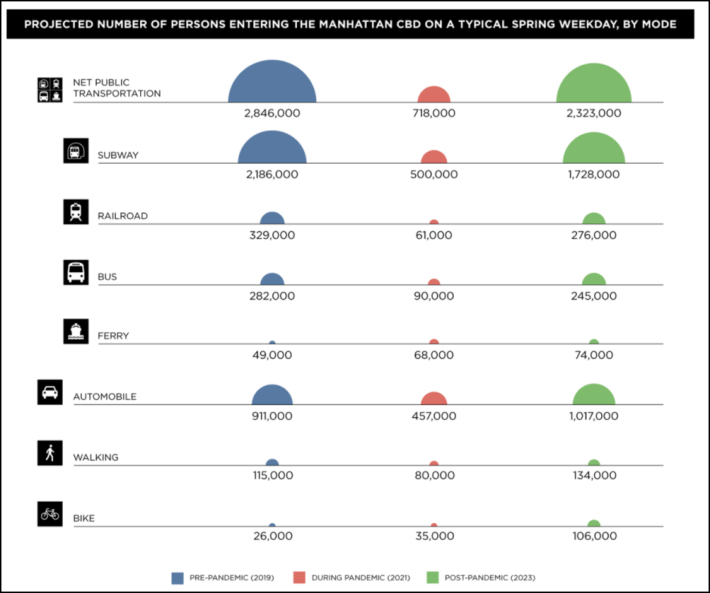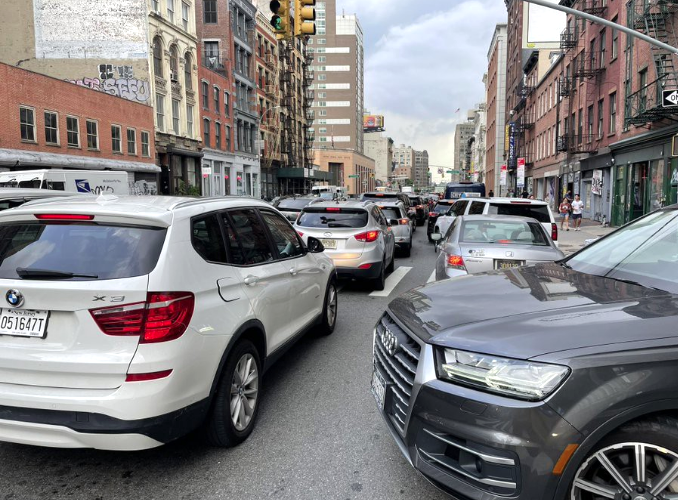This is the dawning of the age of Carpocalypse.
A new look at post-pandemic travel patterns predicts that fewer people will travel into Midtown and Lower Manhattan in the near-future, but more of them will choose to get there by driving, turning a currently miserable morass of traffic into something even more miserable — the very scenario that many experts warned the mayor about last year, but were ignored.
Sam Schwartz Engineering and Clarion Research surveyed Connecticut, New Jersey and New York residents on their travel habits into Manhattan south of 60th Street and ask them how they would change after the pandemic. The bad news? The answers suggest that almost 90,000 extra private cars are going to jam the streets of the city's central living district in 2023. More bad news? The share of public transportation trips into the area is also going to drop.
"Driving into Manhattan, which plateaued for many years and even declined in the 2010s, is expected to rise by almost 90,000 vehicles per day — leading to more congestion, pollution, and added tension on our streets," the report states. "This should be addressed before the streets become overwhelmed."
Here's a breakdown of the core problem: On a typical spring weekday before the pandemic, roughly 23 percent of trips into Manhattan south of 60th Street were done with private vehicles. During the pandemic, that number rose to 35 percent. Now, by 2023, that share will fall to 28 percent, according to the survey, but that seemingly small 5-percent increase from pre-pandemic numbers is a disaster in the making.
Such a shift, the report authors say, "would translate to an increase of as many as 85,000 vehicles entering the CBD daily (assuming 1.25 people per vehicle), likely causing a significant increase in congestion in an area where traffic speeds already normally hover around 7 mph, according to the 2019 Mobility Report by the New York City Department of Transportation."
In terms of raw numbers, the travel pattern shift would mean the total number of people in cars entering the CBD would rise from 911,000 per day to 1,017,000 per day. Meanwhile, the spine of the region's transportation system — commuter rail, buses and the subway — will continue its decline in ridership from before the pandemic. Yes, more people will walk, take ferries or bike, but not enough to make much of a difference in the coming carmageddon, as the chart below shows:

Yes, there is going to be a roughly 320,000-person decrease in the number of people who go into Manhattan's core by 2023 — from 3.9 million people daily to 3.58 million people in 2023, but the 500,000-plus drop in overall transit trips will mostly be made up by drivers because of decreases in transit use.
The subway had an outright majority of trips into the CBD in 2019, with 56 percent of the total share, but the survey suggests it will drop to 48 percent by 2023. Additionally, the total share of public transportation trips into the CBD is predicted to fall from 73 percent to 65 percent.
About one-third of survey respondents said that they were expecting to use public transit less often when traveling into the CBD. Working from home more often was the main reason cited for less public transit usage in that cohort, with 36 percent strongly agreeing with the statement, "I expect to be working from home more." The other two reasons though, show that elected officials and the MTA are going to have to put in some work to change hearts and minds:
- 33 percent of survey respondents who said they were going to use transit less to get to the CBD strongly agreed with the statement, "Public transit will not be as safe from crime as other transportation options."
- And 31 percent strongly agreed with the statement, "Public transit will not be as safe from viruses as other transportation options."
In both of those areas, perception is worse than the reality, said Sam Schwartz Engineering CEO Sam Schwartz. To try to calm people's fears of crime without putting a police officer on every train, Schwartz said the MTA could learn from examples that were included in a recent TransitCenter report on policing and mass transit.
"As that report noted, we should look to other cities’ programs, like BART’s unarmed 'Community Ambassadors,' SEPTA’s creation of a center for people experiencing homelessness in a major station, and TriMet’s study of how design elements like lighting can help improve security along with accessibility and pedestrian safety," he said.
To deal with fears of getting sick, Schwartz said that air quality testing was the best way to prove to people what transit professionals already know: public transportation isn't a vector for the coronavirus.
"To allay fears of the virus, New York City should do what London has done: test the air and surfaces at the busiest subway locations frequently," said Schwartz. "They should also do contact tracing in transit as well which many Asian and European cities have done. They should be transparent about the results, which to date elsewhere have not shown transit to be a Covid vector."
The data also offers another alarming trend beyond the car commute: The report predicts that the total share of CBD travelers on a typical weekday who are aged 18 to 34 is going to rise from 40 percent before the pandemic to 44 percent of the total share of travelers into the area in 2023.
That wouldn't be such a big deal, except that the number crunchers from Clarion Research said that increase in car trips is mostly being fueled by that younger generation, which is following the trend of their car-buying counterparts nationally (insert generational warfare and global warming irony here.)
"The projected increase in 2023 auto trips into the CBD vs. 2019 is tied to the 18-34 year old age cohort," the researchers wrote. "On the other hand, 35-54 year olds are projecting roughly the same number of auto trips into the CBD in 2023 as they did in 2019, and the oldest age group (the 55-plus-year-old cohort) is projecting that overall they will take fewer trips into the CBD in 2023 ... by auto."
Some of the missing transit trips are predicted to be replaced by less destructive travel modes than private cars: Daily cycling trips are expected to rise from 26,000 per day in 2019 to 106,000 per day in 2023, and even walking is expected to get a boost from 115,000 strolls to 134,000 hikes by 2023.
The suggestions to fix the problem before it overwhelms the tenuous street ecosystem in Manhattan are familiar to anyone who's been paying attention to the issue or alerted the mayor, who then ignored the suggestions for some reason. Beyond pushing for speedy implementation of congestion pricing, the report authors say the city should promptly install more bus and bike infrastructure and also require carpool lanes on bridges.
At one of his daily press availabilities last week, the mayor was asked about his surrender to a traffic hell, especially when he was warned about it, and he responded that he's looking very strongly at some traffic restrictions like HOV lanes (something he has said many times before, yet never implemented), but that he's mostly hoping people will return to mass transit.
"There's clearly a problem of too many people in cars," de Blasio said last Wednesday. "We're going to look at [short-term traffic relief measures]. We're going to look at other options of how to address it. In the meantime, I think the big picture is keep fueling the recovery in every way, the vaccinations ... because that's also going to help people feel more comfortable going back to mass transit."






